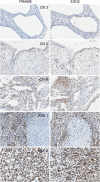PRAME protein expression in DICER1-related tumours
- PMID: 35297207
- PMCID: PMC8977278
- DOI: 10.1002/cjp2.264
PRAME protein expression in DICER1-related tumours
Erratum in
-
PRAME protein expression in DICER1-related tumours.J Pathol Clin Res. 2022 Nov;8(6):579-581. doi: 10.1002/cjp2.293. Epub 2022 Aug 20. J Pathol Clin Res. 2022. PMID: 35986592 Free PMC article. No abstract available.
Abstract
DICER1 syndrome is an autosomal dominant tumour predisposition syndrome usually affecting persons under 30 years of age. Many of the associated benign and malignant lesions occur almost exclusively in DICER1 syndrome. One such tumour, pituitary blastoma (pitB), overexpresses PRAME 500x above control levels. PRAME (PReferentially expressed Antigen in MElanoma) is expressed in malignancies that are not DICER1-related (e.g. melanoma). To address whether PRAME expression is part of the DICER1 phenotype, or simply a feature of pitB, a series of 75 DICER1-mutated specimens and 33 non-mutated specimens was surveyed using immunohistochemistry for PRAME, together with EZH2, which complexes with PRAME. In DICER1-mutated specimens, positive staining for PRAME was only seen in malignant tumours; 7 of 11 histological types and 34/62 individual tumours were positive, while non-tumourous lesions were always negative. Pleuropulmonary blastoma (PPB) showed a continuum in staining, with type I lesions being PRAME negative (n = 7) but all type II and type III lesions PRAME positive (n = 7). Similarly, cystic nephroma (CN) was negative (n = 8), with anaplastic sarcoma of the kidney being positive (n = 2). However, one atypical CN with mesenchymal cell proliferation was PRAME-positive. Embryonal rhabdomyosarcoma (RMS) with DICER1 pathogenic variants (PVs) was positive for PRAME (5/6), but the same tumour type without DICER1 PVs was also positive (9/15). Staining for EZH2 corresponded to that seen with PRAME, validating the latter. This study leads us to conclude that (1) PRAME expression occurs in two-thirds of DICER1-related malignancies; (2) PRAME may be a marker for the progression that certain DICER1-related lesions are thought to undergo, such as PPB and CN; and (3) PRAME expression in some tumours, such as RMS, appears to be an intrinsic feature of the tumour, rather than specifically related to DICER1 PVs. Therapy directed against PRAME may offer novel treatment options in patients with the DICER1 syndrome.
Keywords: DICER1; PRAME; anaplastic sarcoma of the kidney; cystic nephroma; pleuropulmonary blastoma.
© 2022 The Authors. The Journal of Pathology: Clinical Research published by The Pathological Society of Great Britain and Ireland & John Wiley & Sons, Ltd.
Figures



References
-
- Foulkes WD, Priest JR, Duchaine TF. DICER1: mutations, microRNAs and mechanisms. Nat Rev Cancer 2014; 14: 662–672. - PubMed
Publication types
MeSH terms
Substances
Grants and funding
LinkOut - more resources
Full Text Sources
Medical
Research Materials

